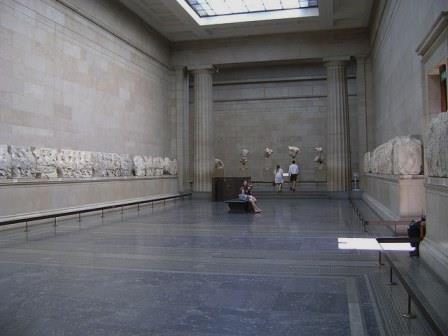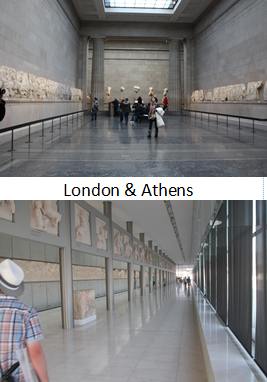"The Duveen Gallery's display of the Parthenon marbles is a disgrace" - see both Chris Hitchens's book and Mary Beard's.
The Gallery is of the same dimensions as the Parthenon building - Sir Joseph Duveen insisted on that as a condition of his 'gift' of £1m.
But there just less than 50 per cent of the frieze is displayed so as to give the false impression that it's complete.
More honestly, the Acropolis Museum in Athens indicates clearly where pieces are missing and has delicately placed small notices with the initials BM beneath those spaces.

The frieze is moreover displayed on the inner walls of an interior room. [not - as on the original - on the outside.]
The New Acropolis Museum displays theirs [also less than 50 per cent the right way round - and] in sight of the original building (which still stands), and most particularly, with streams of Attica daylight pouring through the huge windows facing the Acropolis instead of the muted and depressing lighting of interior Bloomsbury. "
Where are the Parthenon marbles best dislayed?
Check out Professor Sandis' 'Against Principles' article here.
Read here why it continues to be a cultural outrage that this peerless work of art continues to be divided, mainly between Athens & London.
BCRPM acknowledge that the British Museum, with its vast and important collection, is preeminent among the great museums of the world, particularly so for its standards of curation, display, research and education. We question however the concept of the universal/world/encyclopaedic museum and its justification for the continued impairment of one the most magnificent examples of world art.
We continue to remember Christopher Hitchen's words as the Acropolis Museum prepared to open its doors to the public in June 2009:
The Acropolis Museum has hit on the happy idea of exhibiting, for as long as following that precedent is too much to hope for, its own original sculptures with the London-held pieces represented by beautifully copied casts. This has two effects: It allows the visitor to follow the frieze round the four walls of a core "cella" and see the sculpted tale unfold (there, you suddenly notice, is the "lowing heifer" from Keats's Ode on a Grecian Urn). And it creates a natural thirst to see the actual re-assembly completed. So, far from emptying or weakening a museum, this controversy has instead created another one, which is destined to be among Europe's finest galleries. And one day, surely, there will be an agreement to do the right thing by the world's most "right" structure.


Comments powered by CComment